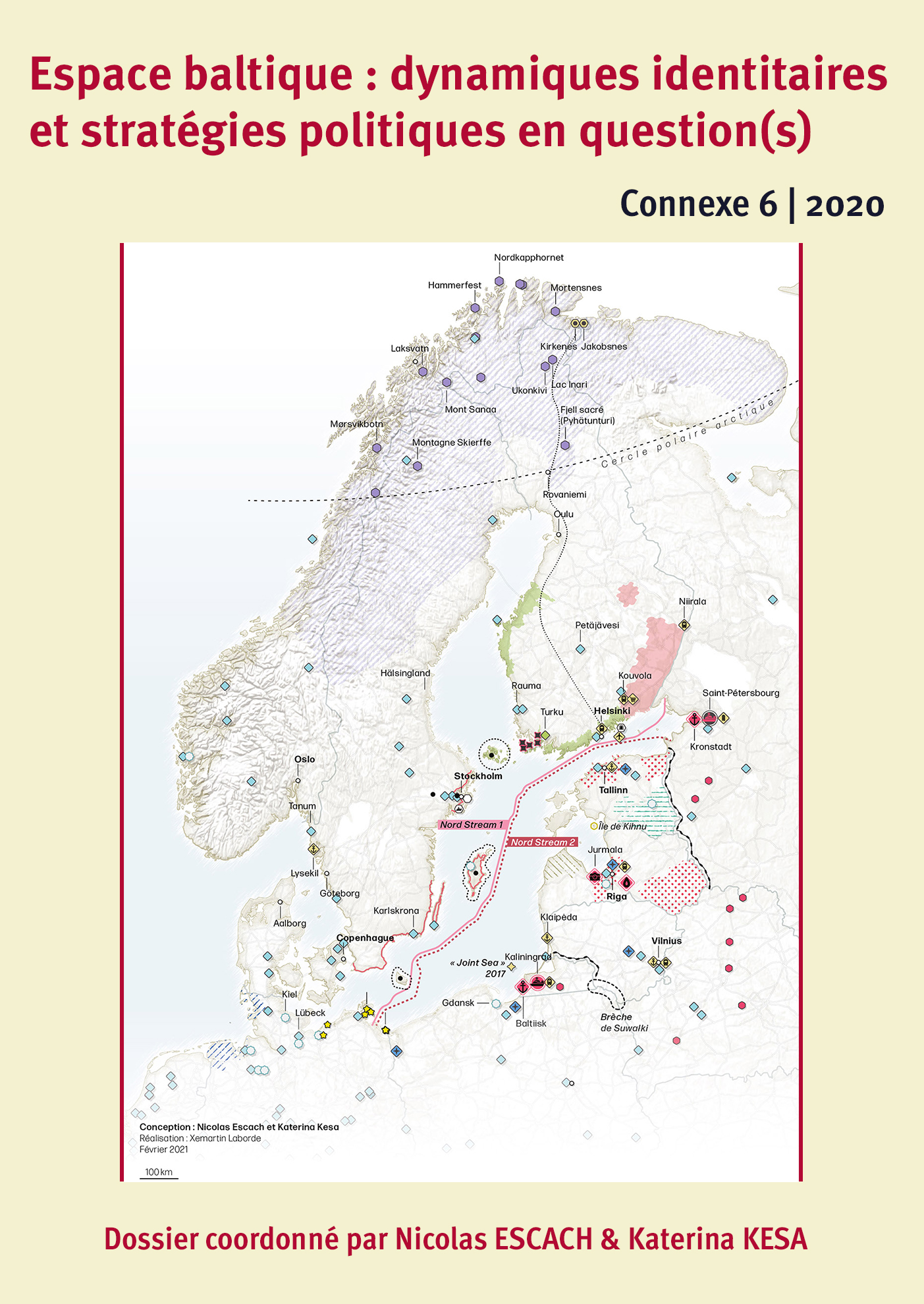Paysage urbain et identités collectives à Kaliningrad
DOI:
https://doi.org/10.5077/journals/connexe.2020.e338Keywords:
urban landscape, Kaliningrad, Königsberg, collective identityAbstract
Urban landscape is an indicator which reveals the organisation of society as well as the political and social strategies it develops. Kaliningrad is not new to this. The Russian city and region of the same name, landlocked within the European Union, has experienced many historical ruptures which can be seen in its landscape. Kaliningrad, the Soviet city, acquired and renamed in 1946 after the end of the Second World War, had to model its new Soviet identity. The city’s German past was erased from official narratives. As a war trophy, the city’s layout structures the organisation of social life and celebrates the Soviet victory with numerous monuments. At the end of the 20th century, Kaliningrad rediscovers Königsberg, the German city of which few material traces remain. This historiographical opening is accompanied by a new materialisation process of the German identity in the urban landscape, which becomes a new identity attribute for the city as well as a dissonant tourist attraction. This period is synonymous with significant autonomy for local authorities following the fall of the USSR, interrupted at the beginning of the 2000s by the strengthening of the vertical of federal power and the Russian national affirmation in urban areas in Kaliningrad. Recurrent debates to rename the city will not succeed. Regardless of these ruptures, the local population created its own identity, without completely distancing itself from its Russian belonging. A phenomenon that is particularly illustrated by the local name of the current city used by its young inhabitants: “Kenig,” a shortened form for Königsberg.
References
Amundsen, Michael. 2019. “Humanizing the robot: Kaliningrad’s House of Soviets and the state of decay.” Ambiances [Online], Varia.
Archer, Clive, and Tobias Etzold. 2010. “The European Union and Kaliningrad: Taking the Low Road.” Geopolitics 15 (2): 329–344.
Berger, Stefan. 2010. “How to be Russian with a Difference? Kaliningrad and its German Past.” Geopolitics 15 (2): 345–366.
Berger, Stefan, and Paul Holtom. 2008. “Locating Kaliningrad and Königsberg in Russian and German Collective Identity Discourses and Political Symbolism in the 750th Anniversary Celebrations of 2005.” Journal of Baltic Studies 39 (1): 15–37.
Bouchard, Michel. 2013. « La Grande Guerre patriotique : narrations sociales et monuments de guerre ». Anthropologica 55 (1) : 113–126.
Carrère, Emmanuel. 1986. Le détroit de Behring. Introduction à l’uchronie. Paris : Ed. P.O.L.
Cybriwsky, Roman. 2013. “Königsberg and Kaliningrad: An Historic European City and a Strategic Exclave of Russia.” Focus on Geography 56 (4): 117–123.
Dementyev, Ilya. 2015. “From ‘Ancient Slavialand’ to ‘Paradise Lost’: The Rehabilitation of the Historical Heritage in Kaliningrad (Late 1940s to Early 1980s),” 126–145. In Contact Zones in the Historical Area of East Prussia XXX. Klaipėda: Klaipėdos Universiteto.
Diener, Alexander, and Joshua Hagen. 2011. “Geopolitics of the Kaliningrad Exclave and Enclave: Russian and EU Perspectives.” Eurasian Geography and Economics 52 (4): 567–592.
Eaton, Nicole M. 2013. “Exclave: Politics, Ideology, and Everyday Life in Königsberg- Kaliningrad, 1928–1948.” Doctoral dissertation, UC Berkeley.
Hirt, Sonia. 2013. “Whatever happened to the (post)socialist city?” Cities, Current Research on Cities 32: 29–38.
Kauffmann, Jean-Paul. 2016. Outre-terre. Paris : Gallimard, Collection Folio.
Kolossov, Vladimir, et Jean Radvanyi. 2014. « Kaliningrad : “l’exclave” russe rêve d’intégration européenne ». Regards de l’Observatoire franco-russe.
Костяшов, Юрий. 2016. “Кёнигсбергский Кафедральный Собор и Могила Иммануила Канта в Советском Калининграде.” Кантовский Сборник 35 (4): 79–102.
Kowalczyk, Halina (dir.), et al. 2019. “Fortress Kaliningrad.” OSW Centre for Eastern Studies.
Lebow, Katherine. 2013. Unfinished Utopia: Nowa Huta, Stalinism, and Polish Society, 1949-56. Cornell University Press.
Le Normand, Brigitte. 2014. Designing Tito’s Capital: Urban Planning, Modernism, and Socialism in Belgrade. Pittsburgh: University of Pittsburgh Press.
Rethmann, Petra. 2008. « Nostalgie à Moscou ». Anthropologie et Sociétés 32 (1-2) : 85–102.
Serrier, Thomas. 2010. « Nier ou intégrer l’héritage allemand ? À propos de l’appropriation culturelle de Danzig, Königsberg et Reval à Gdańsk, Kaliningrad et Tallinn ». Revue germanique internationale 11 : 223–234.
Sezneva, Olga. 2007. “We Have Never Been German...”. In Practising Culture, ed. Craig Calhoun and Richard Sennett, 13–34. Routledge.
Sezneva, Olga. 2013. “Architecture of Descent: Historical Reconstructions and the Politics of Belonging in Kaliningrad, the Former Königsberg.” Journal of Urban History 39 (4): 767–787.
Siegień, Paulina. 2016. “How Much Königsberg is in Kaliningrad.” New Eastern Europe 23 (5): 115–122.
Tétart, Frank. 2007. Géopolitique de Kaliningrad: une « île » russe au sein de l’Union européenne élargie. Paris : Presses de l’Université Paris-Sorbonne.
Thiesse, Anne-Marie. 1999. La création des identités nationales : Europe XVIIIe–XXe siècle. L’Univers historique. Paris : Ed. du Seuil.
Torbakov, Igor. 2014. “The Russian Orthodox Church and Contestations Over History in Contemporary Russia.” Demokratizatsiya 22 (1): 145–170.
Articles de presse :
Артамонова, Александра. 2018. “Немота стены”. NoviiKaliningrad.ru.
Haffner, Pierre. 14.05.2018. « Le FSB contre les régionalistes à Kaliningrad ». Blogs.mediapart.fr.
Хлебников, Вадим. 2018. “Конец политики”. Новый Калининград.
NoviiKaliningrad.ru. 03.12.2018a. “Алиханов о возможном переезде мэрии в Дом Советов: 'Мы там вместе все не поместимся'”.
NoviiKaliningrad.ru. 27.11.2018b. “'Имя врага': в Калининграде облили краской памятник Канту (фото)”.
NoviiKaliningrad.ru. 04.12.2018c. “В конкурсе имен для аэропорта “Храброво” победила Елизавета”.
Ria Novosti. 29.10.2018. “Аэропорту Калининграда могут присвоить имя Иммануила Канта”.
Sites web :
Amnesty International. 05.07.2018. « Igor Roudnikov, Kaliningrad ».
Baltic Republican Party. Деловая жизнь.
Голос.11.09.2017. “Выборы в Калининграде: подкуп и катастрофический подсчет”.
Entretiens avec des scientifiques :
Stefan Berger, historien de l’Université de Bochum en Allemagne, spécialiste des nationalismes et de Kaliningrad, 11 juin 2019, via vidéoconférence depuis Bruxelles.
Daria Bocharnikova, historienne de l’architecture soviétique, professeure à la KU Leuven, Belgique, 11 juin 2019, Bruxelles.
Olga Sezneva, sociologue spécialisée des sociologies culturelles et urbaines et spécialiste de Kaliningrad, Université d’Amsterdam, Pays-Bas, 19 juin 2019, via vidéoconférence depuis Bruxelles.
Jamie Freeman, historien de l’Université d’East Anglia, Grande-Bretagne, et auteur d’une thèse de doctorat sur les aménagements soviétiques de Kaliningrad, 1 juillet 2019, via vidéoconférence depuis Bruxelles.
Downloads
Published
How to Cite
Issue
Section
License
Some rights reserved 2021 Colin Horenbeek

This work is licensed under a Creative Commons Attribution 4.0 International License.




